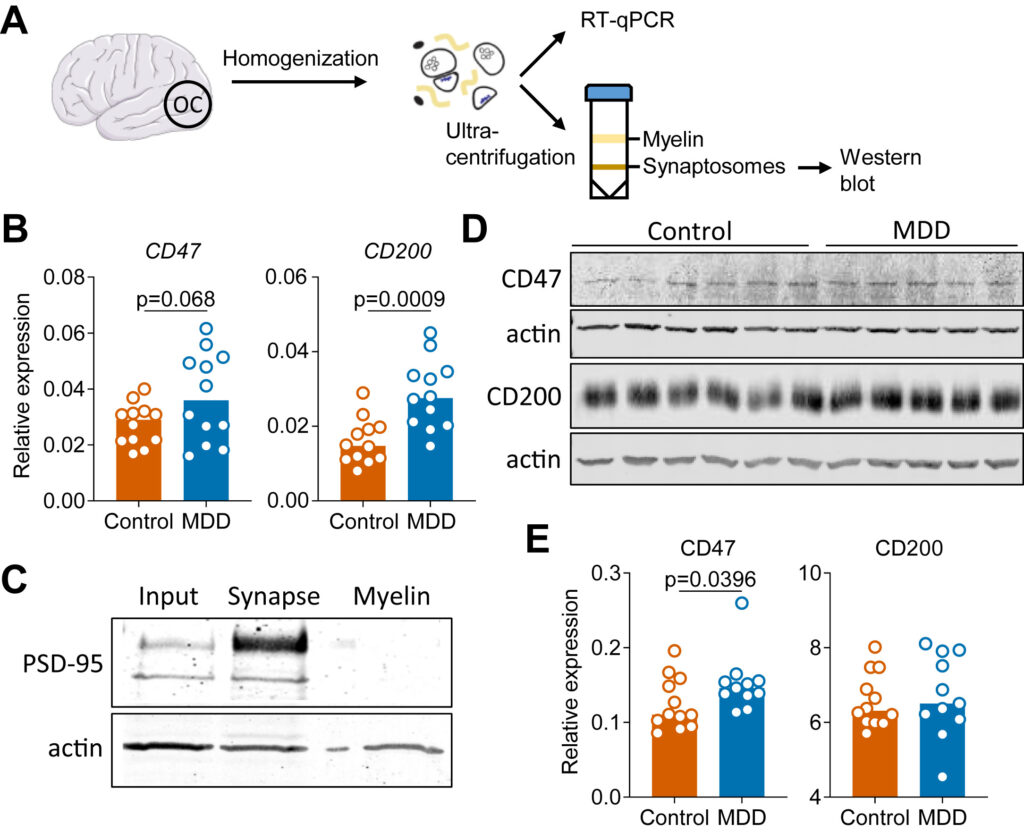Biological Psychiatry
Volume 94, Issue 8, 15 October 2023, Pages 619-629
Archival Report
Microglia Transcriptional Profiling in Major Depressive Disorder Shows Inhibition of Cortical Gray Matter Microglia (大うつ病性障害におけるミクログリア転写プロファイリングは、皮質灰白質ミクログリアの阻害を示す)
Karel W F Scheepstra 1, Mark R Mizee 2, Jackelien van Scheppingen 2, Adelia Adelia 3, Dennis D Wever 2, Matthew R J Mason 4, Marissa L Dubbelaar 5, Cheng-Chih Hsiao 6, Bart J L Eggen 5, Jörg Hamann 6, Inge Huitinga 7
- Neuroimmunology Research Group, Netherlands Institute for Neuroscience, Amsterdam, the Netherlands; Psychiatric Program of the Netherlands Brain Bank, Netherlands Institute for Neuroscience, Amsterdam, the Netherlands; Department of Psychiatry, Amsterdam University Medical Centers, Amsterdam Neuroscience, Amsterdam, the Netherlands.
Received 15 February 2022, Revised 1 February 2023, Accepted 17 April 2023, Available online 28 April 2023, Version of Record 15 September 2023.
Abstract
Background: Microglia have been implicated in the pathophysiology of major depressive disorder (MDD), but information on biological mechanisms is limited. Therefore, we investigated the gene expression profile of microglial cells in relation to neuronal regulators of microglia activity in well-characterized MDD and control autopsy brains.
Methods: Pure, intact microglia were isolated at brain autopsy from occipital cortex gray matter (GM) and corpus callosum white matter of 13 donors with MDD and 10 age-matched control donors for RNA sequencing. Top differentially expressed genes were validated using immunohistochemistry staining. Because gene expression changes were only detected in GM microglia, neuronal regulators of microglia were investigated in cortical tissue and synaptosomes from the cortex by reverse transcriptase-quantitative polymerase chain reaction and Western blot.
Results: Transcriptome analysis revealed 92 genes differentially expressed in microglia isolated from GM, but none in microglia from white matter in donors with MDD, compared with control donors. Of these, 81 genes were less abundantly expressed in GM in MDD, including CD163, MKI67, SPP1, CD14, FCGR1A/C, and C1QA/B/C. Accordingly, pathways related to effector mechanisms, such as the complement system and phagocytosis, were differentially regulated in GM microglia in MDD. Immunohistochemistry staining revealed significantly lower expression of CD163 protein in MDD. Whole tissue analysis showed an increase in CD200 (p = .0009) and CD47 (p = .068) messenger RNA, and CD47 protein was significantly elevated (p = .0396) in synaptic fractions of MDD cases.
Conclusions: Transcriptional profiling indicates an immune-suppressed microglial phenotype in MDD that is possibly caused by neuronal regulation.
Abstract
背景 ミクログリアは大うつ病性障害(MDD)の病態生理に関与しているが、その生物学的メカニズムに関する情報は限られている。そこでわれわれは、よく特徴づけられたMDDおよびコントロールの剖検脳において、ミクログリア細胞の遺伝子発現プロファイルを、ミクログリアの活性を制御する神経細胞との関連において検討した。
方法 大うつ病性障害患者13名と年齢をマッチさせた対照患者10名の後頭葉皮質灰白質(GM)と脳梁白質から、剖検時に純粋で無傷のミクログリアを単離し、RNA配列決定を行った。免疫組織化学染色を用いて、上位の発現差遺伝子を検証した。遺伝子発現の変化はGMミクログリアでのみ検出されたため、大脳皮質組織と大脳皮質のシナプトソームにおいて、逆転写酵素-定量ポリメラーゼ連鎖反応とウェスタンブロットによりミクログリアの神経細胞制御因子を調べた。
結果 トランスクリプトーム解析の結果、MDDドナーの白質から分離したミクログリアでは、対照ドナーと比較して92遺伝子が異なって発現していたが、対照ドナーの白質から分離したミクログリアでは発現していなかった。このうち81遺伝子はMDDのGMで発現量が減少しており、CD163、MKI67、SPP1、CD14、FCGR1A/C、C1QA/B/Cが含まれた。従って、補体系や貪食などのエフェクター機構に関連する経路は、MDDのGMミクログリアにおいて異なる制御を受けていた。免疫組織化学染色により、MDDではCD163タンパク質の発現が有意に低いことが明らかになった。全組織分析では、CD200(p = 0.0009)とCD47(p = 0.068)のメッセンジャーRNAが増加し、MDD症例のシナプス画分ではCD47蛋白が有意に上昇した(p = 0.0396)。
結論 転写プロファイリングは、大うつ病性障害において免疫抑制されたミクログリアの表現型を示し、それはおそらく神経細胞の制御によって引き起こされている。
Keywords: Depression; Microglia; Psychiatry; RNA sequencing; Synaptosomes.

Discussion
我々は、大うつ病と臨床診断されたドナーのGMミクログリアは、WMミクログリアではなく、DepDAMと名付けた疾患関連ミクログリア(DAM)トランスクリプトーム・プロファイルを示した。GMミクログリアのDE遺伝子の大部分(92個中81個)は発現減少されており、免疫応答(MK167, SPP1, C1QA/B/C)や貪食機能(FCGR1A/C, FCGR3A, CD14, CD163)に関与する遺伝子が多かった。個々の遺伝子と一致して、パスウェイ解析では、免疫活性化(補体系、誘導性一酸化窒素合成酵素シグナル伝達、インターロイキン12シグナル伝達)と貪食活性(貪食の調節、膜浸潤、貪食、貪食におけるFcγ受容体シグナル伝達、インターロイキン12、toll様受容体、TREM1シグナル伝達)に変化がみられた。対照ドナーと比較して、MDD GMミクログリアの免疫抑制状態は、分離直後に評価されたCD45膜発現の低下からも明らかであった。
まとめると、大うつ病の後頭葉皮質では、おそらく神経細胞制御によって引き起こされる、免疫抑制された灰白質ミクログリアの表現型が示唆された。貪食能と補体活性化が低下したアパシー型ミクログリアの状態は、MDDに関連するシナプス代謝と結合性に重要な結果をもたらす可能性がある。DepDAMの表現型は、ヒトの脳で同定されているミクログリア状態の連続性にさらに拍車をかけている。
a04cb50a84a6efbb16f9131d6a29ca8fReferred to by
Depressive Disorder–Associated Microglia as a Target for a Personalized Antidepressant Approach
Biological Psychiatry, Volume 94, Issue 8, 15 October 2023, Pages 602-604
本日のジャーナルクラブは、医学類2年生のHさんが初めて論文紹介を行いました。医学類3年のNさんがプログレスセミナーを行いました。学業で忙しい中、がんばりました!
1969年に創刊されたBiological Psychiatryは、Biological Psychiatry学会の機関誌であり、Biological Psychiatryファミリーの最初の雑誌である。関連誌にCognitive Neuroscience and NeuroimagingおよびBiological Psychiatryがある。 本学会の目的は、思考、感情、行動の障害の性質、原因、メカニズム、治療法を研究する分野において、卓越した科学研究と教育を推進することである。この使命に基づき、本誌は査読制、迅速出版の国際ジャーナルとして、精神疾患とその治療に対する理解を深める、独創的な基礎、トランスレーショナル、臨床のメカニズム研究の斬新な成果を掲載する。また、現在の研究や関心のあるトピックに焦点を当てた総説や解説も奨励している。
Biological Psychiatryは、精神神経科学分野で最も厳選され、被引用数の多い学術誌の一つである。Biological Psychiatryの2022年のインパクトファクターは10.6である。Clarivate Analyticsが発表した2022年のJournal Citation Reportsでは、インパクトファクターで、精神医学155タイトル中12位、神経科学272タイトル中17位にランクされている。総引用数では、Biological Psychiatryは精神医学分野で第2位。また、Google Scholar(2022年7月)によれば、精神医学分野で5位にランクされている。
